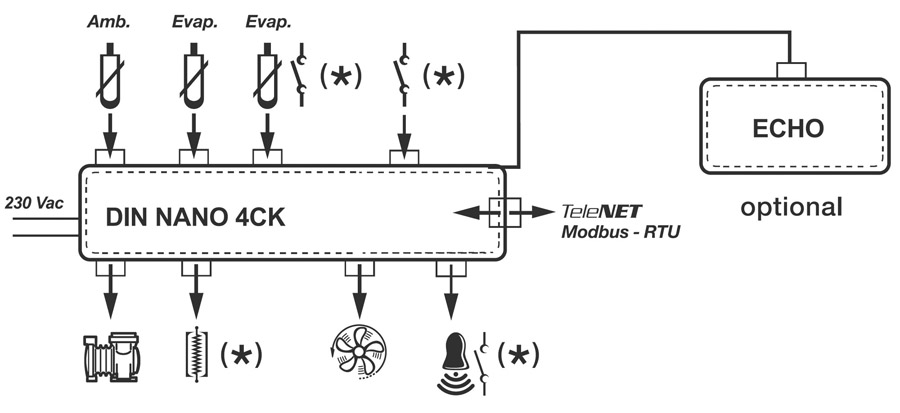PRODUCTS | MODULAR ELECTRONICS
DIN NANO 4CK
DIN RAIL 4-RELAY ELECTRONIC REGULATOR


The DIN NANO 4CK is a 4 relays electronic regulator DIN rail designed to control refrigerated counters, display windows and static or ventilated refrigeration units with off-cycle or electrical defrosting in real time (RTC). It is fitted with three analogue inputs for NTC temperature probes, one of which is configurable as a digital input, an additional digital input, four relays for the compressor control, fans, defrosting function and alarm and buzzer.
As option the connection to an echo temperature repetition.


Applications
-
Control of refrigerated counters, display windows and refrigeration units.
-
Control of two evaporators with two temperature probes of end defrost.
Main characteristics
- Can be configured for hot, cold or neutral zone applications.
- Can be configured for managing day / night (automatic modification of the setpoint for energy saving) activated by time mode (real time clock) or by means of the digital input.
- Can be configured to manage two evaporators with dual temperature sensor for defrost termination.
- Relay managing compressor and fans of evaporator (2 non-configurable relays) and defrosting resistances, alarm, pump down start, room light and compressor output (2 configurable relays).
- Defrosting activation in real-time, up to 6 starts in 24h.
- Defrosting can be configured for off-cycle, heating element or cycle inversion and frequency and durationcan be set. End-of-defrosting can be based on time or temperature.
- Key operated manual START/STOP defrosting.
- Key operated ON/OFF.
- Cold room light ON/OFF switch with key or by means of door switch (if defrost output is configured like cold room light).
- A temperature repeater echo display is available as an option.
- 3-figure LED display sign, decimal point and plant status icons.
- Internal buzzer for acoustic signals.
- PEGO programming philosophy guaranteeing immediate start-up.
- RS485 serial connection with Modbus-RTU or Telenet protocol.
- Power supply 230Vac.
- HACCP function with memory and visualization of the last alarm.
Properties
Dimension
DIN NANO 4CK
DIN NANO: 105x121,5x71 mm
DISPLAY: 93x37x23,1 mm
DISPLAY: 93x37x23,1 mm
Weight
DIN NANO 4CK
0,5kg
Front protection rating
DIN NANO 4CK
IP 65 with front board installation
Power supply
DIN NANO 4CK
230 VAC ±10% 50/60 Hz
Absorbed power
DIN NANO 4CK
5 VA max
Working temperature
DIN NANO 4CK
-5 ÷ +50°C
Storage temperature
DIN NANO 4CK
-10 ÷ +70 °C
Relative ambient humidity
DIN NANO 4CK
30% - 90% RH without condensate
Display
DIN NANO 4CK
3-Digit with sign, decimal point and LED status indicators
Resolution
DIN NANO 4CK
0,1 °C
Reading range
DIN NANO 4CK
-45 ÷+99 °C
Connections
DIN NANO 4CK
Screw removable clamps
Software class
DIN NANO 4CK
A / parameters saved on non-volatile memory (EEPROM)
Clock (RTC)
DIN NANO 4CK
Present
Analogue
DIN NANO 4CK
2 ingressi per sonde NTC (10kΩ 1% a 25°C)
Digital
DIN NANO 4CK
1 ingresso (da contatto pulito)
Configurable
DIN NANO 4CK
1 input for NTC probes (10KΩ 1% at 25°C) or digital input (free voltage contact)
Alarm/AUX relay
DIN NANO 4CK
(DO4) N.O. 8(3)A / 250V
Supervision
DIN NANO 4CK
TeleNet / Modbus-RTU
Compressor relay
DIN NANO 4CK
(DO1) N.O. 16(6)A / 250V
Heatings elements relay
DIN NANO 4CK
(DO2) N.O. 16(6)A / 250V
Fan relay
DIN NANO 4CK
(DO3) N.O. 16(6)A / 250V
Buzzer
DIN NANO 4CK
Present
Buzzer
DIN NANO 4CK
Present
Technical Characteristics
Inputs
Outputs
Display Features
Dimensions and Diagram

